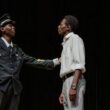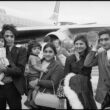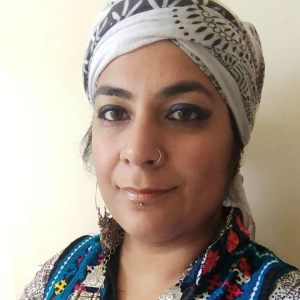I write this on the lands of the Whadjuk people of the Noongar nation, and I humbly acknowledge them as the traditional custodians of the lands on which I live, work and play. I pay my respect to the elders of this land, past, present and emerging, and acknowledge that sovereignty was never ceded. This is, was, and always will be Aboriginal Land.
As I reflect on my Acknowledgement of Country[1], I think about what it means to be a settler-migrant, living on stolen, occupied land – because that is exactly what Australia is. It still exists under the Crown, this former penal colony that hides dark histories. There is a reason that one of the slogans I see most often at protests is ‘White Australia has a Black History’: It is simultaneously an acknowledgement of the terrible injustices that have been levelled against the Indigenous people of this land; and also a recognition, that this place is built on the sovereign lands and bodies of Blak[2] people.
The assertion of Terra Nullius, that the land was unoccupied, has been evoked time and again to justify the colonial project. This particular claim to possession completely reduced the lives and identities of Aboriginal peoples to nothing more than flora and fauna. In a single phrase, it stripped them of humanity and their right to exist, in favour of establishing new playgrounds for empire; it displaced Indigenous people from the lands they had lived on for over 65,000 years and massacred communities.

The Australian state grew from these beginnings. Aboriginal people were made refugees on their own homelands, forced into missions and reserves, their movements restricted. Those who resisted were killed, and trophies such as the ears of the dead were nailed to walls. They were exposed to Western diseases that killed many. The Stolen Generation, where mixed-race children were taken from their families, land and culture, meant that many lost their connections with their identities and languages.
Looking at all this, it is no wonder that discrimination and racism towards Aboriginal people has been internalised to such a degree that it is embedded in the very institution of Australia.
Throughout, though, there was resistance, and a push for change and recognition. The push from Aboriginal activists, fighting against systemic discrimination and political decisions, led to acknowledgement of the severe issues that affected Aboriginal people. The declaration of Terra Nullius was formally overturned by the High Court in 1992 after a years-long challenge from 5 Indigenous Meriam people from the Torres Strait. The same year, Prime Minister Paul Keating made the admission in his now famous Redfern Park speech, that the ongoing difficulties that affected Aboriginal people were directly linked to European settlement. In 2008, Prime Minister Kevin Rudd made a national apology for the Stolen Generation.

Small steps, some have said, but towards what?
It is nearly 30 years since the Mabo decision[3]. However, the justification for colonisation is still believed and voiced by some of those in power: in 2014, then Prime Minister – and Minister for Indigenous Affairs – Tony Abbott declared that on ‘discovery’, Sydney was ‘nothing but bush’, and in 2018 a retired Abbott said that the arrival of the British was ‘a good thing’, completely ignoring the massacres and displacement of Indigenous peoples from the land. Some conservative politicians walked out of the Apology in 2008, with current Minister for Home Affairs Peter Dutton defending his actions while further maligning Aboriginal communities.
This reflects an uneasy truth: That many of those in power continue to erase and declare Aboriginal identity as less valid than (white) settler identity. It means that current practices that disproportionately target Aboriginal people are likely to be downplayed, or even defended, such as their overrepresentation in the prison system and increased chances of dying in custody.

Currently the rates of indigenous incarceration stand at 29% of the total prison population, despite them making up only 3% of the total country’s population, with horrific cases of abuse, mistreatment, negligence and deaths in police custody being recorded. The practice of locking people up for non-payment of fines is only just being addressed. Let’s be clear: the situation is not improving, with over 430 Indigenous deaths in custody recorded since the Royal Commission into Aboriginal Deaths in Custody (RCIADIC) in 1991. It isn’t just the numbers that are alarming; it is also the contexts of these deaths. Mr Ward[4] quite literally cooked to death in the back of a police van in the heat. Ms Dhu was denied medical care and attention despite being clearly unwell, and was left to die. Other cases of mistreatment have led to self-harm and suicide. The use of spit-hoods over the heads of minors incarcerated in Don Dale prison in the Northern Territory has also come to light, as an example of harsh policing methods on minors that includes the use of restraints and isolation.
These events, and the many others that are only now being spoken about, paint a dire picture of what it means to be Aboriginal today. Is it really any wonder then that we hear the cry that Blak Lives Matter?

Arundhati Roy, in her 2004 lecture on being awarded the Sydney Peace Prize, said ‘We know of course there’s really no such thing as the “voiceless”. There are only the deliberately silenced, or the preferably unheard.’ The term ‘deliberately silenced, preferably unheard’ is an apt descriptor of how Australia deals with those who are considered a threat to a particular way of being, of existing. More often than not it is linked, in public discussion and in policy, to those who are not white. From controlling borders and migrant intakes, to locking up asylum seekers in offshore detention centres, to the over-policing and systemic discrimination against Indigenous people, there is a very clear link between the ideals that were laid out as foundations for Australia, and the current treatment of those who do not conform to the state by virtue of their very existence.
Unfortunately, building solidarity is difficult. It is very easy to ignore the issues, particularly when concerned about our own safety and status as migrants. For all the declarations around multiculturalism, Australia isn’t exactly known for welcoming people with open arms. Fear can be a strong deterrent. Some may also fall into the ‘model migrant’ trap, celebrated for assimilating Australian values and practices, for being productive and therefore useful to a capitalistic society, amplifying class divisions in communities. The desire to be accepted unfortunately sometimes includes adopting and amplifying negative attitudes towards Aboriginal people, including wilful ignorance around the history and systemic factors that affect them.

Before I moved here, I did not know any of Australia’s history, let alone the history of its First Nations people. I have come to learn this from friends and comrades, from protests and discussions, from wanting to know exactly what the history of my adopted home is. However, it is not exactly known well even amongst people who have spent their whole lives here. Most of Australia’s dark history is mysteriously absent from the national curriculum, and popular media voices are polarising when discussing Aboriginal issues.
This is why visibility is so important. One of the most potent protest practices for people who have been silenced and made invisible in this way is to simply be visible – to take up space in public, to exist in spaces that they have otherwise been denied access to, and to refuse to be the ‘deliberately silenced, or the preferably unheard’. This becomes particularly important in the case of rallies and other actions that occur in central city spaces, as this is where they will have most visibility. The choice of urban, commercial spaces as the backdrop for protests also carries weight as these spaces were once off-limits to Aboriginal people – their very movements were restricted to times and spaces where it would not interfere or cause unease amongst the colonisers’ interests. Reclaiming the spaces, disrupting them and raising the Aboriginal flag becomes a declaration of sovereignty and a reminder that even now, we are on contested land. After all, what greater threat is there to the myth of the white ethnostate than the sheer existence of Blak and brown bodies?

As a protest photographer, then, I strive to amplify those voices that are usually shushed, the stories of the people who have been resisting for so long. Black Lives Matter may have begun as an American movement, but Aboriginal people have been fighting for the very same principles since the First Fleet landed. The movement is a recognition of how little these lives have mattered when it has come to serving someone else’s interests. I have learnt my solidarity from the stories of resistance that have been shared with me, and from those who have stood with me, by me, who have welcomed me on to their land even as they mourn because they recognise the need to keep on fighting together.
[1] An Acknowledgement of Country is a statement before an event, article or other public communication where someone who is not from the specific Aboriginal background states that they acknowledge those who were here before colonisation. Where a member of the Aboriginal group is involved, particularly an Elder, they may do a Welcome to Country.
[2] Local references to Aboriginal people are stylised as ‘Blak’ as an identity, distinct to African migrants, similar to ‘Black’ being used in the US to denote African American identity.
[3] The Mabo Decision introduced the doctrine of Native Title, and hence recognised the land rights of Indigenous peoples in Australia and the Torres Strait as existing before colonial occupation.
[4] In line with Aboriginal traditions, those who have died are not referred to by their first names.








